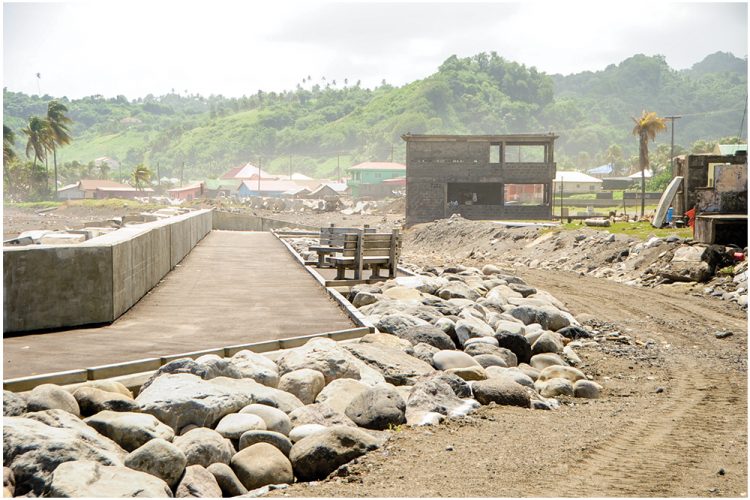New coastal sea defense for Georgetown

For decades the residents of Georgetown who live along the coast lived in fear of surging seas claiming lives and property especially during the hurricane season.
Now, they can rest much easier with the completion of a EC$25 million Coastal Defence project funded by the World Bank and comprising sea defense work in the Brownstown area and at Caratal.
The Caratal component of the project stretches northward for about 200 meters from the entrance to the Caratal river and costs EC$11million.
Hyacinth Morris, a 61-year-old resident of Caratal told SEARCHLIGHT that for the first time in decades, she has been able to sleep comfortably at night.
“I lived here all of my life, and there was a lot more land between here (her house), and much further out where the sea is right now. But unless we who live here tell you, people would not know how much land the sea took from us.”
Morris pointed out the distance the sea would surge inland, waves lapping the main road and entering mainly homes whose foundations were closer to ground level.
“The water never got into my house because my house is built high enough, but it was still uncomfortable. I remember there was a large board house up there,” she said pointing to an area north of her home, “and one year the hurricane damaged it. People use to live there but they had to go and live somewhere else,” she said.
“Many people had to leave their homes and you can see so many houses just there. The sea took some already, but people had no choice but to go and live elsewhere. I am sleeping much better at nights, and since the wall is there, we can even relax outside at nights. We hear the sea, but we know we are safe. I believe that the workmen did a very good job,” she added.
Kendall Jackson, a resident of Georgetown praised the project saying that it enables residents who live along the coast to “better sleep at nights.”
The Regional Disaster Vulnerability Reduction Project, implemented by the St Lucia company OB Sadoo Engineering Services, was due for completion in August this year but was delayed to October 2021, because of the COVID-19 pandemic and the eruptions of La Soufriere which displaced some of the workers.
Site Engineer Luzanne Edwards, said eight foot walls were built to prevent waves from encroaching, causing damage to property; and a three-metre wide footpath was constructed. There are also plans to beautify the length of the seafront to make it more attractive to residents.
A drain was constructed to take waste water from the distillery to the river. At the river mouth there is a problem, according to Prime Minister Dr. Ralph Gonsalves. He pointed out that there would have to be a separate project “to have a correction there because the river mouth is lower than the sea level.”
This results in the accumulation of silt at certain times of the year that forces water to back up, and bulldozers have to be used to clear the blockage.
Edwards said during the construction phase of the project, the presence of sargassum seaweed was a major challenge, in that it “caused a smell barrier for the divers” in the pools created to place the Xblocks.
The next phase of the project is the Sandy Bay coastal sea defense project which may start early in 2022.
Surrendra Singh, Acting Programme Manager for the Natural Disaster Management Programme said that the Sandy Bay study was completed before the eruptions changed the shoreline. As a result, an update will be done to ascertain the accuracy of the changes and their impact. BRAGSA did a geo-technical study a few weeks ago, and the firm of Smith Warner International is doing the design for the Sandy Bay project.









